You didn't go into business thinking your restaurant would be delivery only, but it's not too late to adapt and thrive

Those who are able to adapt quickly by immediately offering delivery to support customer needs will stand the best chance of both surviving and thriving.
Overnight, the restaurant industry was upended by the coronavirus pandemic. With doors forced shut and restaurant transactions in the United States plummeting by as much as 71% at the end of March 2020, many in the industry are left with no choice but to pivot their restaurants to a delivery model—and fast.
Below, we’ll share examples of restaurants that have shifted their business models to focus on online ordering and delivery services with the help of technology and software—and offer strategies for how you can do the same quickly and cost-effectively.
6 strategies for pivoting to delivery to your restaurant
It may seem like a daunting task to not only stand up a delivery service overnight but also ensure your customers make use of it right away. But as countless restaurants have found, it can be done if you implement these strategies:
1. Announce updates on your website and social media
More than at any other time, customers are going to be looking for information about your restaurant online.
Use your website and social media accounts to announce how your restaurant will be adapting and changing in this new era. If you don’t already have a website, now’s the time to set one up.

Seattle-based restaurant Canlis announces a change in business model on its website (Source)
“Fine dining is not what Seattle needs right now,” says Seattle’s fine-dining restaurant Canlis in a note on its website. “Instead, this is one idea for safely creating jobs for our employees while serving as much of our city as we can.”
On its website the restaurant announced three new dining options: a takeout breakfast service called The Bagel Shed, a lunch pickup offering called Drive On Thru, and a home-cooked meal for home delivery called Family Meal.
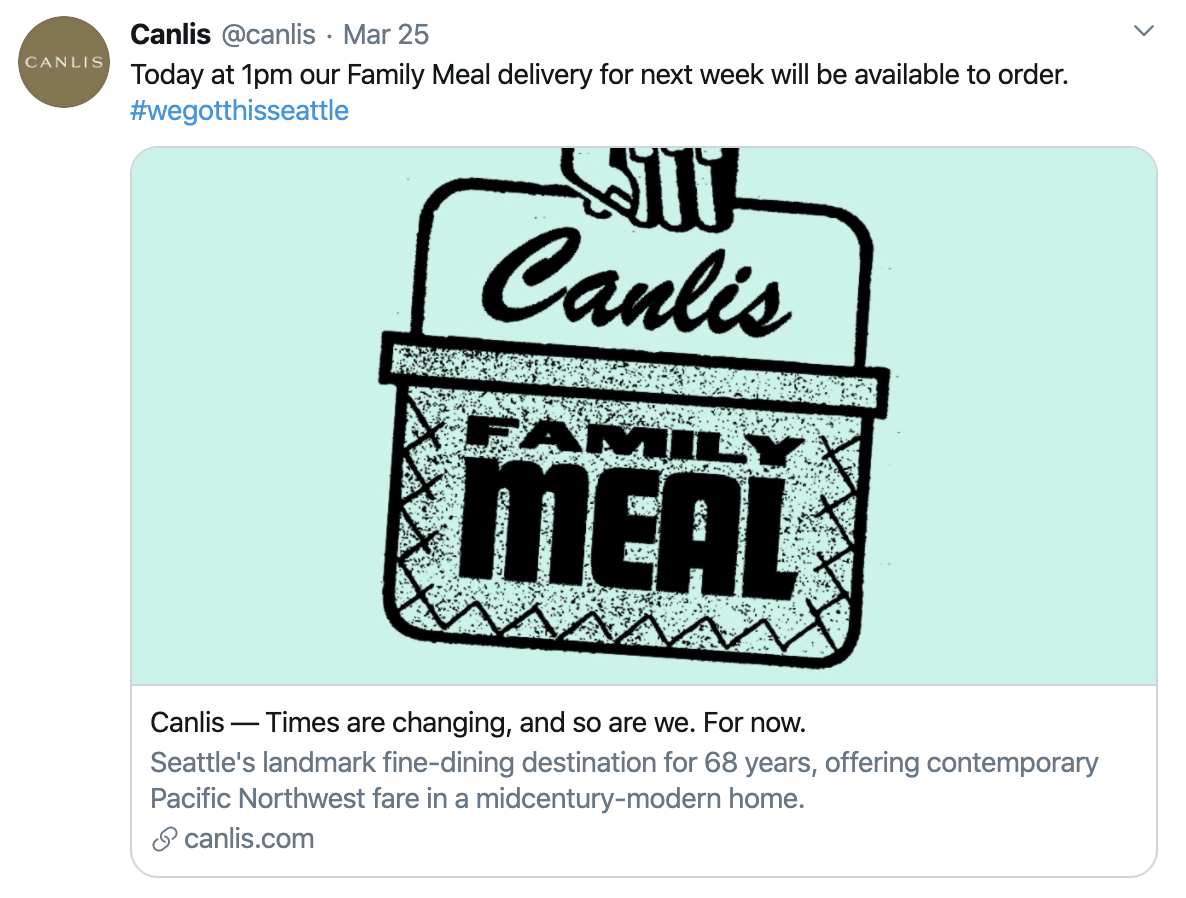
Canlis communicates its new meal offerings on Twitter (Source)
Similarly, on Twitter, the restaurant shared an update of its new offerings to its 12,000 followers. Social media is now one of the most cost-effective ways to reach out to customers who are already following you and want to continue giving you business.
If you’re looking to further keep track of your followers, their interactions, and social media marketing efforts, consider investing in social media management tools to maximize your outreach efforts and see what offerings are piquing the most interest.
Make sure you include the following:
Update your new operating hours and contact information
State clearly what services you’re providing (e.g., pickup and delivery) and showcase your menu
Explain how pickup and delivery services will be offered
Detail how sanitation and hygiene measures will be taken
2. Revamp your menu to focus on profitable and delivery-friendly items
“Pare down your menu” has been a prevalent directive as restaurants shift quickly to takeout and delivery services to meet changing customer needs.
Here’s why: With restaurants operating on thinner margins and with reduced staff, every item on your menu must maximize profit and be delivery-friendly.
Minimizing, simplifying, and consolidating your menu will not only control and reduce your inventory costs—it’ll make cooking and delivery easier on your employees and more cost-effective for your business.
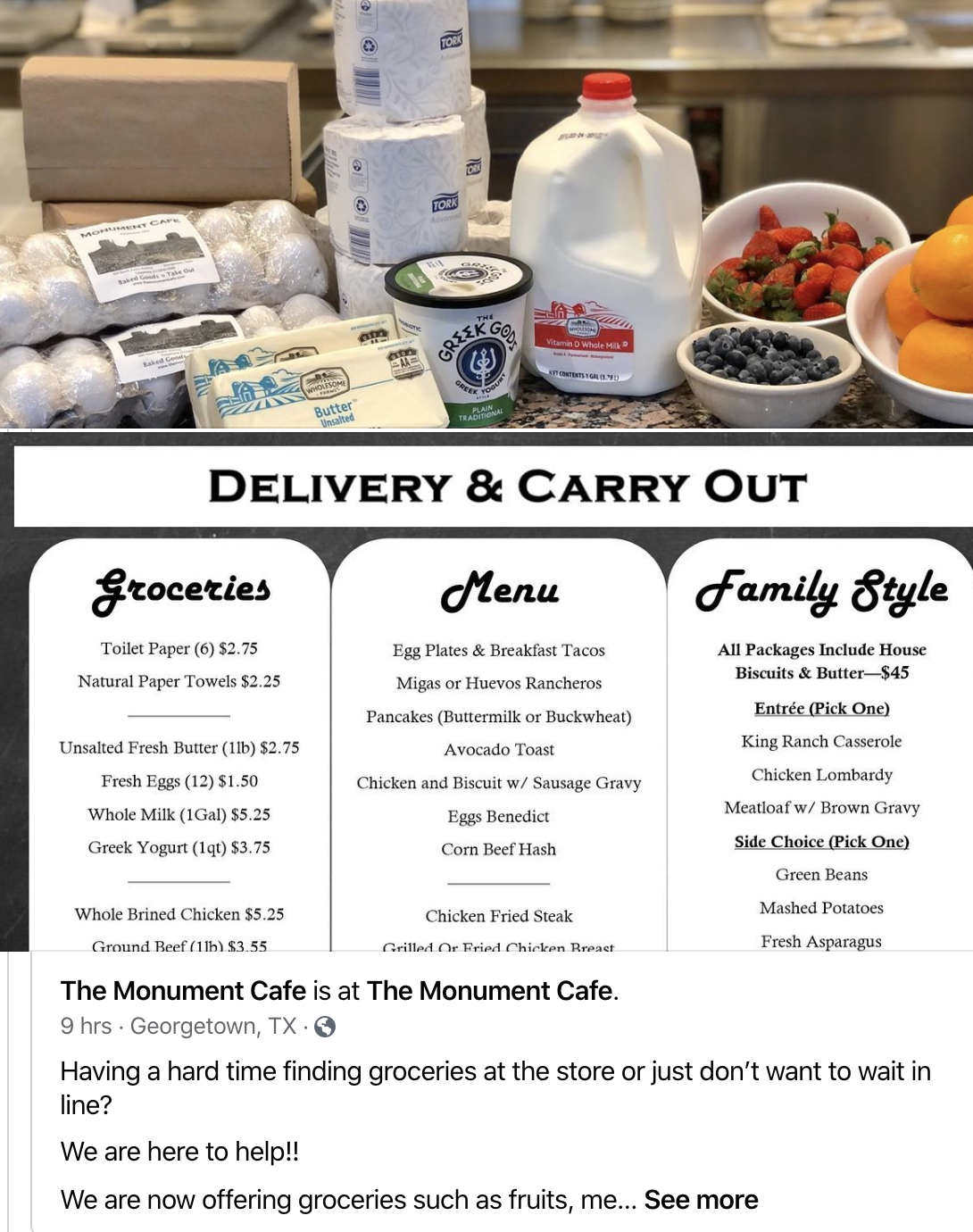
Monument Cafe offers groceries and new menu offerings through takeout and delivery (Source)
Additionally, restaurants are getting creative with their offerings. In the case of The Monument Cafe above, it has moved into the grocery business to provide essential items such as meats, dairy items, and toilet paper. This will help clear its surplus inventory and will also serve those avoiding trips to grocery stores. On top of that, the restaurant is providing a delivery-friendly, family-style menu for its customers.
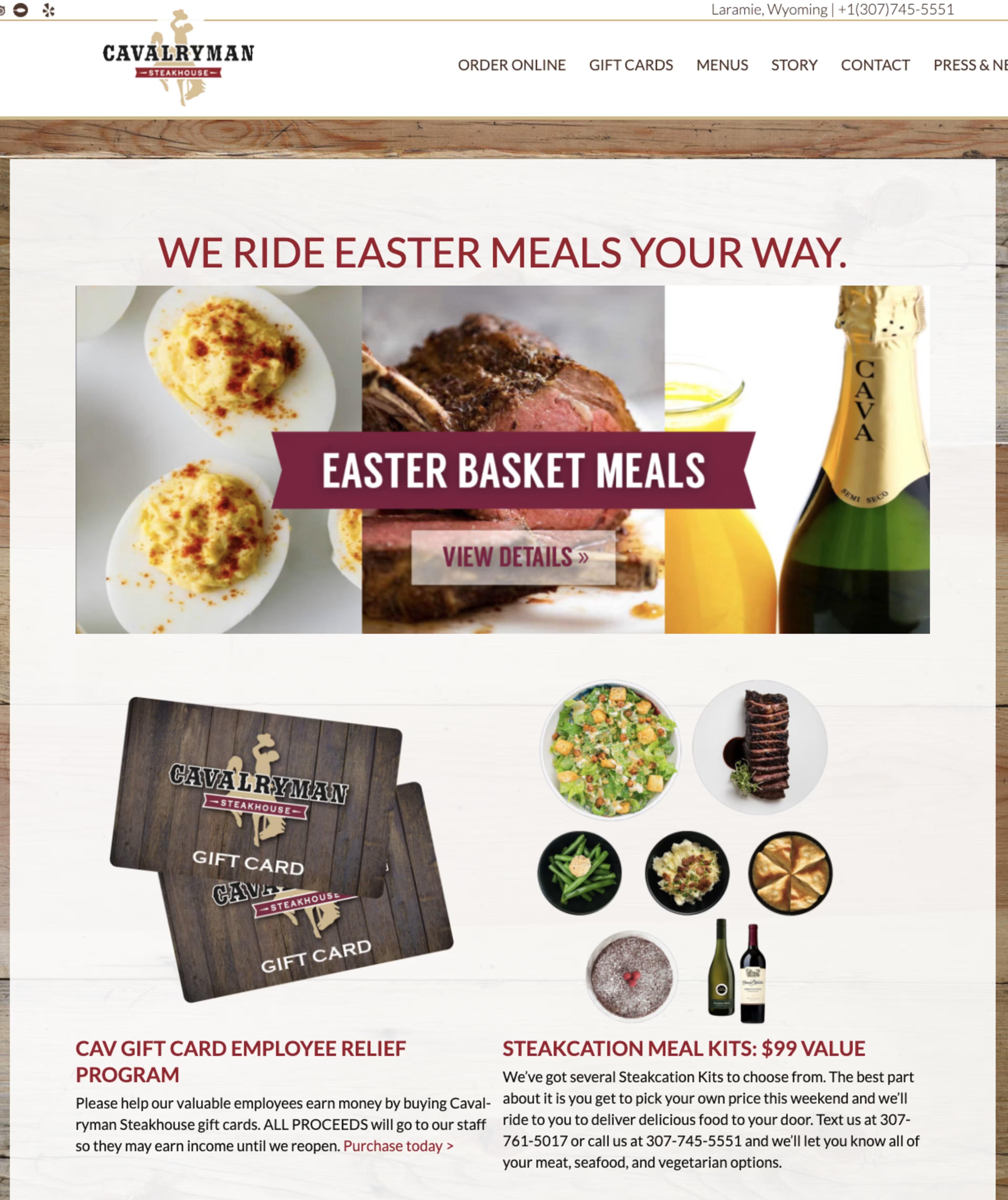
Cavalryman Steakhouse now delivers meal kits and holiday basket meals (Source)
Calvaryman Steakhouse, a restaurant heavily reliant on dine-in business, has shifted to providing pickup and delivery options for “Steakcation” meal kits, lunch meals, and even Easter family meals.
Using your restaurant POS system, take stock of your existing inventory and use the ingredients you already have to build your new menu. Doing so provides your restaurant with a financial buffer as you work through existing items without needing to order new inventory.
There is a great deal of food costing software that can help with recipe and menu costing to increase profitability.
Consider the following when you’re revamping your menu:
Which items on your dine-in menu travel well?
What can be reheated and refrigerated without compromising food quality?
What are the most popular and best-selling items on your menu?
Are there essential goods of which you need to clear inventory?
Dig into past sales reports on your restaurant management POS. Most sales report dashboards will give you an overview of all transactions and allow you to see which menu items are most profitable to determine a strategy for optimizing your restaurant’s new online menu.
3. Use all online ordering and delivery technologies available
Shortly after government officials issued a statement about the severity of the pandemic, sales at Cavalryman Steakhouse immediately dropped by as much as 70%, Kate Lacroix, CMO of Blue Sky Group restaurants and manager of the dine-in restaurant, says.
The restaurant, which previously did not have any online ordering and delivery options, then quickly pivoted to pickup and delivery services through its website and third-party platforms. In its first week, it delivered close to $3,000 in sales.
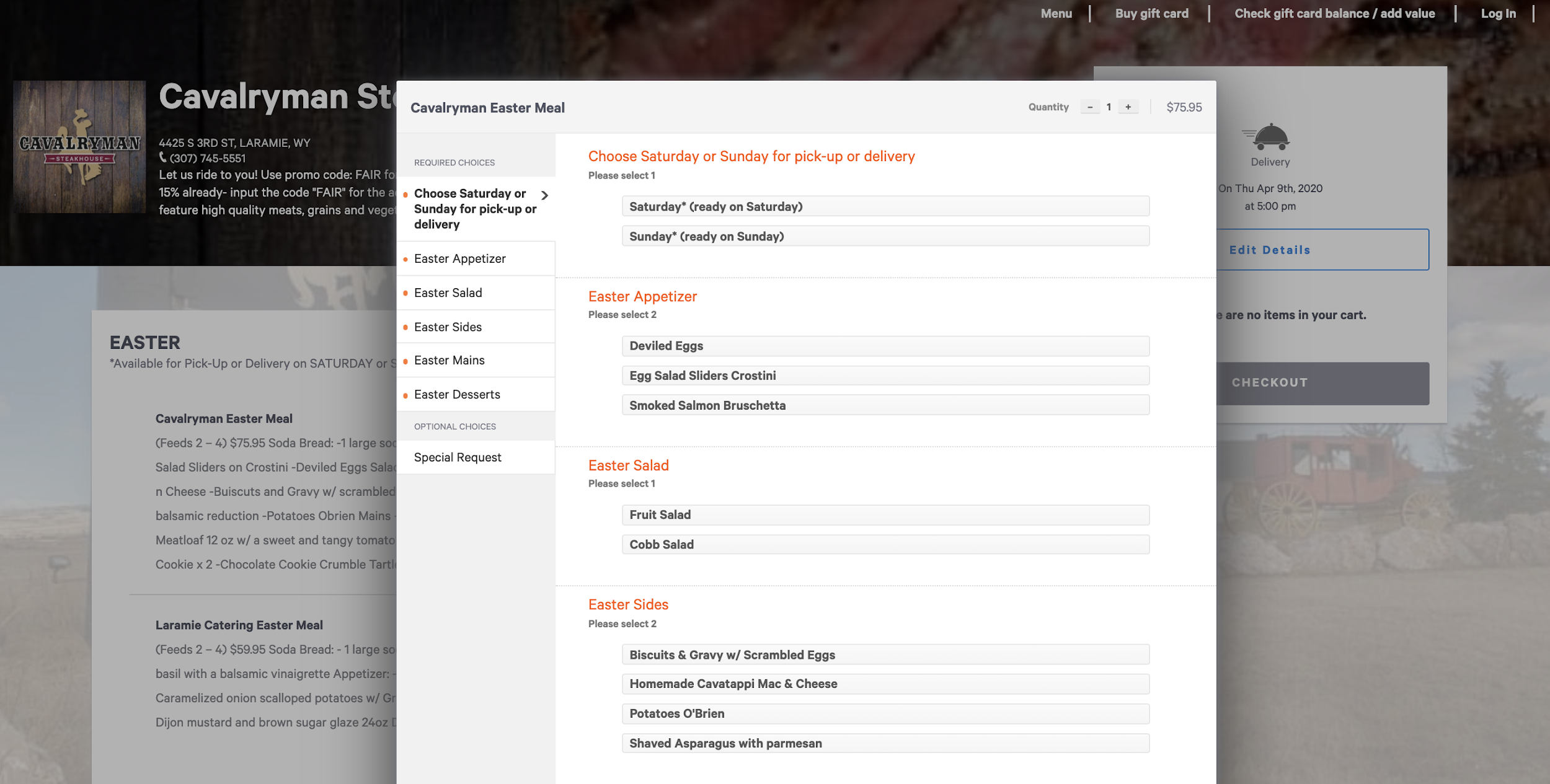
Cavalryman Steakhouse provides online ordering and delivery on its website through Toast (Source)
For most restaurants like Cavalryman, curbside and delivery services are now the only viable revenue stream for restaurants during the pandemic. To make this happen at your restaurant, it’s important to be present where your customers are.
Provide online ordering through third-party delivery apps
Through platforms like DoorDash and Grubhub, customers can place orders and make payments. Restaurants are then left to fulfill orders and customers can choose to pick up orders placed through the app or have it delivered to their doorstep. Being present on platforms like these can allow you to reach new customers that were previously unfamiliar with your restaurant.
Be sure to read the fine print before signing up: Some third-party apps are offering a short-term deferral of marketing commission fees (does not include delivery or processing fees) during the pandemic but still require signing up with the platform for at least a year.
Provide online ordering through a platform on your restaurant’s website
There are many benefits to setting up your restaurant’s online ordering and delivery platform on your very own website.
Third-party platforms charge service fees of as high as 30%, so having an in-house platform not only cuts out unnecessary fees, it gives your restaurant control over the delivery process—from menu changes, to receiving online orders, to delivery.
Now is a good time to get in on a good deal. Several software vendors are offering several months free with no commission fees, while others are waiving setup and activation fees. Similar to third-party apps, make sure you understand what you’re signing up for long term.
4. Hire your front-of-house staff as a delivery fleet
With your restaurant forced to close its doors to diners and turn to takeout and delivery services, you likely have employees whose roles seem superfluous at the moment. Have you considered employing your front of house staff through your takeout and delivery business?
That was what Cavalryman Steakhouse did. When it implemented an in-house delivery service, it transformed its entire “front of house” workforce into a delivery fleet.
“We did not want to have to make staffing cuts. 18 employees are involved [as our delivery fleet],” says Lacroix. “Employees use their own vehicles and we reimburse them for gas and mileage,” she adds.
After launching its lunch service, the steakhouse added six hours to each day, with two drivers scheduled for those shifts.
Thanks to an in-house delivery team, Cavalryman Steakhouse was able to keep employees on the payroll, avoid the additional setup and delivery fees that come with reliance on a third-party platform, and be in control of the overall customer experience.
Considerations for hiring FOH for delivery:
Check your local laws forreclassification: Employees may need to be reclassified under the Fair Labor Standard Act (FLSA) if their roles are changed, which may require a different wage.
Determine insurance and gas compensation: Employees must be compensated for mileage using their own vehicles for deliveries. The IRS business mileage standard rate currently stipulates 58 cents per mile. Ensure that your employees and their vehicles are fully insured when they’re out on the road.
Get delivery software to handle the heavy lifting: Whether it’s optimizing your delivery route or having access to up-to-the-second order details, having the right delivery software will make it easier for you to manage your fleet.
5. Communicate your food prep, sanitation, and delivery procedures
During this time of uncertainty, customers will have increased concerns of exposing themselves to the risk of catching or spreading coronavirus. It’s important to build trust with your customers by showing how you seriously you are taking public health.
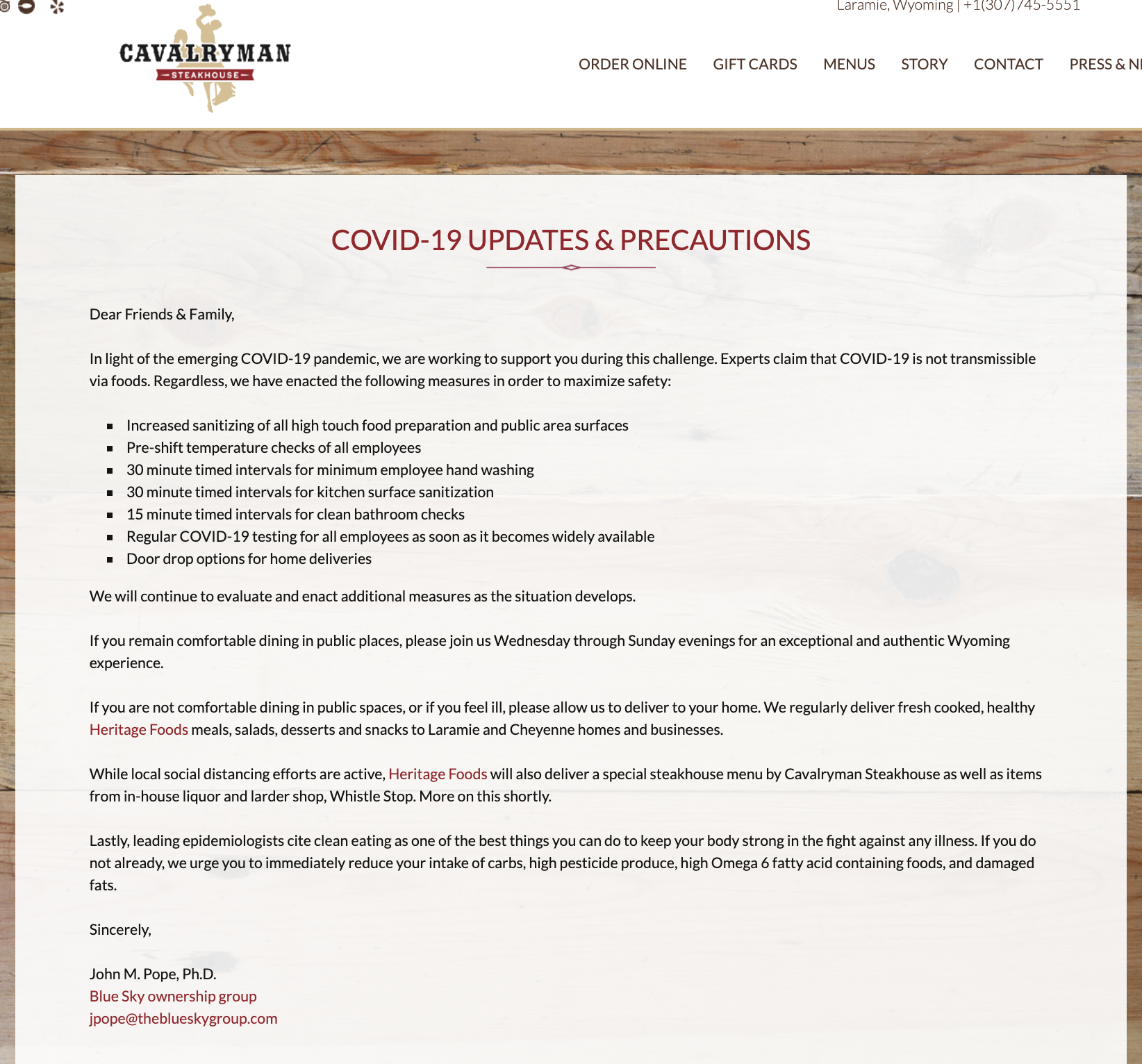
Cavalryman Steakhouse communicates its sanitation measures (Source)
To address lingering concerns, many restaurants are doing due diligence within their walls to protect their customers, employees, and food. Below are a few considerations for what you can do:
Establish protocols for your employees: This includes wearing masks and face coverings, stepping up hand washing, and increasing the frequency of sanitizing public areas, such as countertops, tabletops, and door handles.Enhanced sanitation protocols should be clearly communicated. As basic as they sound, cover all bases and make sure to train your employees on all the above, and then prepare them to confidently and empathetically respond to customers’ questions and concerns over the phone.
Establish contactless food preparation: Some restaurants are taking it a step farther by not touching prepared food with their hands and instead using kitchen tools including tongs and gloves. Food items are then packaged and sealed with tamper-evident labels to indicate that their food has not been touched.
Establish contactless delivery: This is a crucial element of safe food delivery practices, so here’s what to keep in mind:
Give customers the option to request for contactless delivery: You can do so through a button on your online ordering app or provide space to include special instructions.
Train employees for food handling: Remind employees to ask customers if they’d like contactless delivery when taking phone orders. Train your delivery fleet on what contactless delivery looks like and provide them with cleaning and sanitations supplies like hand sanitizer, masks, and gloves.
Encourage online payments and tipping: Enable online payment and tipping options to ensure your team is still able to receive tips for their services during this time of contactless delivery.
Invest in tamper-proof packaging: Make sure your packaging is sturdy and double-sealed so customers have confidence that their order has not been tampered with.
Communicate to your customers: Customers want to know what measures you’re taking to protect them from coronavirus exposure. Communicate the safety measures you’re taking through your social media platforms, email, and website. This helps you establish trust and allay the concerns of your customers.
6. Ensure adding delivery to your restaurant is a long-term strategy
This overnight pivot to adding online ordering and delivery options isn’t just a stopgap measure—it’s here to stay. If you’re new to this, it’s still not too late: your existing customer base already loves your restaurant and are ready to support local businesses.
The sooner you move to an online ordering and delivery business model, the faster your restaurant can adapt and provide your customers with a service that they need for the foreseeable future.
Adapting is the name of the game. While the restaurants above weren’t able to change the circumstances they’ve been dealt as a result of the pandemic, they have all successfully shifted their operations and will continue to do so when this pandemic is over.
Prepare for the future
If you can't make delivery work today, you can make it work in the future. Take a look at Capterra’s food delivery products to see which is the best fit for your business.
Once set up—and should your budget permits—consider other tools such as ecommerce, social media marketing, and food costing platforms that can further optimize your online ordering and delivery services.
Have you pivoted your restaurant to a takeout and delivery business model? We’d love to hear about your experience. Share your comments below.